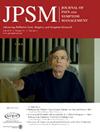评价重度神经损伤患儿气管造口置入术的临床观点
IF 3.2
2区 医学
Q2 CLINICAL NEUROLOGY
引用次数: 0
摘要
Outcomes1。与会者将欣赏临床医生对SNI患儿气管切开术目的位置的不同看法,以及专业/亚专业镜头在形成这种观点方面所起的作用。参与者将能够考虑并权衡SNI患儿在气管切开术目的地位置的道德原则:其中包括自主,慈善,非恶意,无效,共同决策和父母自由裁量权。重度神经损伤儿童气管切开术的目标位置是一个充满道德困境和伦理原则竞争的重大决定。有证据表明,专业镜头既影响道德困扰的程度,也影响提供者优先考虑哪些道德原则。“目的”气管切开术越来越多地被考虑用于永久性严重神经损伤(SNI)[1]儿童。虽然延长了生命,但考虑到高发病率的可能性、医疗保健利用率的增加以及护理者需要改变的生活方式,这个决定是很重要的[2-3]。有证据表明,当提供者和照顾者的价值观不一致时,会增加提供者的痛苦和随之而来的冲突[4-6]。关于提供者观点的全国性调查很少,范围狭窄,并且没有考虑亚专业视角如何影响提供者观点。目的评价临床医生对SNI患儿气管切开术目的位置的不同看法,评估不同的亚专科透镜对这种观点的影响,并回顾围绕这些病例的复杂伦理原则。方法对照顾气管切开术儿童的临床医生进行全国调查。本调查介绍了一例气管切开术在SNI患儿中的应用,并对专业经验和观点进行了评价。结果438名初步调查对象代表了亚专业和专业经验的多样性。受访者对是否应该在实例病例中进行气管切开术存在分歧(55.4%),这表明有多少人认为他们的机构会提供气管切开术(90.2%),以及如果是自己的孩子会选择气管切开术的人有多少(1.4%)存在明显的不一致。被调查者对生活质量的评分(平均27.7±19.2)与被调查者对护理者生活质量评分的假设(平均58.6±16.0)之间存在显著差异。受访者表示在这些情况下经常出现道德困扰(41.5%“有时”,43.2%“经常/总是”)。受访者在判断护理人员或临床医生是否应对决定承担主要责任方面意见不一。只有18.5%的受访者报告了管理此类病例的机构协议,尽管73%的人认为协议会有所帮助。亚专科变异性的分析正在进行中。结论SNI患者气管切开术目的位置的提供者观点存在显著差异。早期证据表明,亚专业晶状体会影响这些视角。罗宾逊WM。儿科慢性有创机械通气的伦理考虑。来自L.M. Sterni, J.L. Carroll(编),照顾呼吸机依赖儿童,呼吸医学,DOI 10.1007/978-1-4939-3749-3_4。2. Maddux AB, Mourani PM, Miller K, Carpenter TC, LaVelle J, Pyle LL, Watson RS, Bennett TD。使用国家所有付款人索赔数据确定儿童长期机械通气后的长期发病率和健康轨迹。儿科危重症护理杂志,2018;23(4):e189-e198。3. Kirk S, Glendinning C, Callery p,父母还是护士?成为依赖科技的孩子的父母的经历。护理杂志,2005,09(5):456-64。4. Wilfond BS。重度残疾儿童的气管切开术和辅助通气:引导家庭和职业价值观。儿科。2014年2月;133增刊1:S44-9。doi: 10.1542 / peds.2013 - 3608 h。5. Kochan M, Cho E, Mercurio M, Greco M, Savarese AM, Falck A. 18三体手术干预的争议。中华儿科杂志,2011,31(1):393 - 393。6. Meyer-Macaulay CB, Dayre McNally J, O'Hearn K, Lynne Katz S, th本文章由计算机程序翻译,如有差异,请以英文原文为准。
Evaluating Clinician Perspectives on Tracheostomy Placement in Children With Severe Neurologic Injury
Outcomes
1. Participants will appreciate the diversity of clinician sentiment surrounding destination tracheostomy placement in children with SNI, and the role that professional/subspecialty lens plays in shaping that perspective.
2. Participants will be able to consider and weigh the ethical principles at place in children with SNI being considered for destination tracheostomy placement: among these are autonomy, beneficence, non-maleficence, futility, shared decision making, and the zone of parental discretion.
Key Message
Destination tracheostomy placement in children with severe neurologic injury is a weighty decision fraught with moral distress and competing ethical principles. There is evidence that professional lens impacts both extent of moral distress and which ethical principles are given primacy by providers.
Abstract
“Destination” tracheostomies are increasingly considered in children with permanent severe neurologic injury (SNI) [1]. Though life-prolonging, the decision is weighty given the likelihood of high morbidity, increased healthcare utilization, and the lifestyle change required of caregivers [2-3]. There is evidence of added provider distress and concomitant conflict where provider and caregiver values disagree [4-6]. National surveys on provider perspectives are few, narrow in scope, and do not consider how the subspecialty lens influences provider perspectives.
Objectives
To evaluate the diversity of clinician sentiment surrounding destination tracheostomy placement in children with SNI, to evaluate how varied subspecialty lenses impact that perspective, and to review the complex ethical principles surrounding these cases.
Methods
A national survey of clinicians who care for children with tracheostomies. The survey introduced an example case of destination tracheostomy placement in a child with SNI and then evaluated professional experience and perspectives.
Results
Four hundred and thrity-eight initial respondents represented a diversity of subspecialty and professional experience. Respondents were divided on whether tracheostomy should be offered in the example case (55.4%) revealing significant discordance both with how many felt their institution would offer tracheostomy (90.2%) and how few would select tracheostomy if the child were their own (1.4%). There was significant discordance between respondents’ rating of quality-of-life in the example case (mean 27.7 ± 19.2) and respondent assumption for how caregivers would rate quality-of-life (mean 58.6 ± 16.0). Respondents reported regular moral distress in these situations (41.5% “sometimes,” 43.2% “frequently/always”). Respondents varied in judging whether caregivers or clinicians should bear primary responsibility for the decision. Only 18.5% of respondents reported institutional protocols for managing such cases, though 73% felt protocolization would be helpful. Analysis of subspecialty variability is ongoing.
Conclusion
There is significant variability in provider perspectives on destination tracheostomy placement in SNI. Early evidence suggests subspecialty lens influences those perspectives.
References
1. Robinson WM. Ethical Considerations in Chronic Invasive Mechanical Ventilation in Pediatrics. From L.M. Sterni, J.L. Carroll (eds.), Caring for the Ventilator Dependent Child, Respiratory Medicine, DOI 10.1007/978-1-4939-3749-3_4. 2. Maddux AB, Mourani PM, Miller K, Carpenter TC, LaVelle J, Pyle LL, Watson RS, Bennett TD. Identifying Long-Term Morbidities and Health Trajectories After Prolonged Mechanical Ventilation in Children Using State All Payer Claims Data. Pediatr Crit Care Med. 2022 Apr 1;23(4):e189-e198. 3. Kirk S, Glendinning C, Callery P. Parent or nurse? The experience of being the parent of a technology-dependent child. J Adv Nurs. 2005 Sep;51(5):456-64. 4. Wilfond BS. Tracheostomies and assisted ventilation in children with profound disabilities: navigating family and professional values. Pediatrics. 2014 Feb;133 Suppl 1:S44-9. doi: 10.1542/peds.2013-3608H. 5. Kochan M, Cho E, Mercurio M, Greco M, Savarese AM, Falck A. Disagreement About Surgical Intervention in Trisomy 18. Pediatrics. 2021 Jan;147(1):e2020010686. 6. Meyer-Macaulay CB, Dayre McNally J, O'Hearn K, Lynne Katz S, Thébaud B, Vaccani JP, Barrowman N, Harrison MA, Jouvet P. Factors Impacting Physician Recommendation for Tracheostomy Placement in Pediatric Prolonged Mechanical Ventilation: A Cross-Sectional Survey on Stated Practice. Pediatr Crit Care Med. 2019 Sep;20(9):e423-e431.
求助全文
通过发布文献求助,成功后即可免费获取论文全文。
去求助
来源期刊
CiteScore
8.90
自引率
6.40%
发文量
821
审稿时长
26 days
期刊介绍:
The Journal of Pain and Symptom Management is an internationally respected, peer-reviewed journal and serves an interdisciplinary audience of professionals by providing a forum for the publication of the latest clinical research and best practices related to the relief of illness burden among patients afflicted with serious or life-threatening illness.

 求助内容:
求助内容: 应助结果提醒方式:
应助结果提醒方式:


